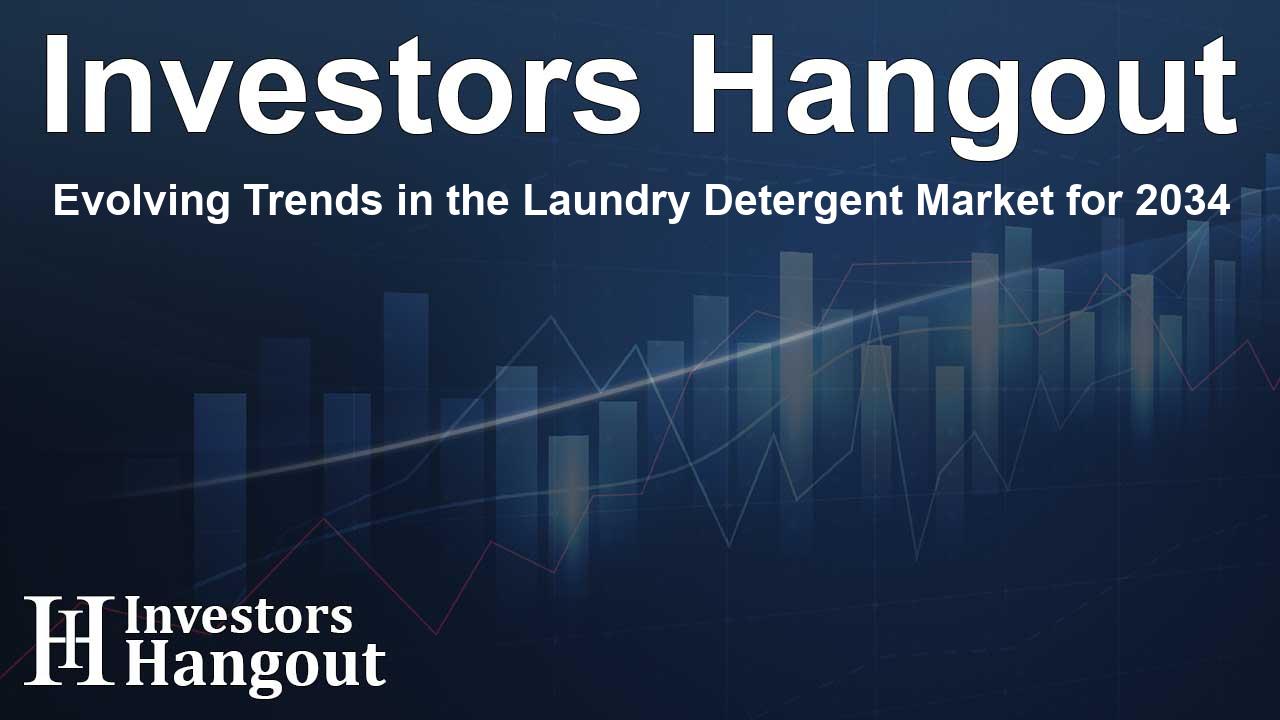Evolving Trends in the Laundry Detergent Market for 2034

Introduction to the Laundry Detergent Market
The laundry detergent market is on a trajectory of considerable growth, with forecasts suggesting a rise from USD 74.2 billion in 2024 to USD 117.6 billion by 2034. This shift is underpinned by a robust compound annual growth rate (CAGR) of 5.2%. As household cleaning needs evolve, detergent manufacturers are responding dynamically, tailoring products to meet changing consumer preferences and technological advancements.
Understanding Laundry Detergents
Laundry detergent is a staple in households, crucial for cleaning clothes and eliminating stains. Available in various forms such as liquids, powders, and pods, these products cater to diverse washing machines and fabrics. The composition typically includes surfactants, enzymes, and crucial active ingredients that perform exceptionally in breaking down oils and dirt for thorough cleaning.
Formulations and Innovations
With continuous technological innovations, modern detergent formulations are increasingly meeting niche demands. Hypoallergenic options, eco-friendly solutions, and specific detergents designed for sensitive skin have become prevalent, indicating a broader focus on personalization and sustainability.
Competitive Landscape of the Market
The laundry detergent sector is marked by fierce competition and rapid innovation. Key players continuously expand their market presence while prioritizing sustainable practices and diverse product offerings. Companies are reevaluating their strategies to integrate eco-friendly products, which is a growing consumer expectation.
Major Industry Players
- Procter & Gamble (P&G)
- Unilever
- Henkel AG & Co.
- Colgate-Palmolive
- Reckitt Benckiser
- Church & Dwight Co., Inc.
- Kao Corporation
- LG Household & Health Care
- S.C. Johnson & Son, Inc.
- Clorox Company
- PZ Cussons
- Amway Corporation
- Ecolab Inc.
- Seventh Generation, Inc.
- The Himalaya Drug Company
Market Dynamics and Trends
As sustainability rises to prominence, many companies are revamping their detergent lines to enhance environmental friendliness. Strategies include reducing packaging waste, introducing plant-based materials, and developing products that consume less water and energy during washing. These changes are motivated by an increased consumer focus on hygiene and cleanliness, propelled further by experiences during the pandemic.
Consumer Insights on Hygiene
Post-pandemic, awareness surrounding cleanliness has heightened, leading to increased demand for detergents that provide deep cleaning and antibacterial features. The market has seen a positive boost in sales, especially for premium and specialized detergents that promise superior results.
Market Trends and Segmentation
Within the laundry detergent market, several key trends have emerged:
- Concentration and Efficiency: An increasing number of consumers are leaning towards concentrated detergents that require less product per wash, aligning with broader sustainability goals.
- Eco-Friendly Packaging: Eco-friendly packaging has gained significant traction as sustainability continues to reshape consumer choices.
Product and Packaging Types
The market is segmented based on product types, packaging, pricing, distribution channels, and regional dynamics. Liquid detergents are dominating due to their versatility; they dissolve quickly in water and work efficiently across various washing machines, making them a popular choice for many consumers.
Recent Developments in the Market
In early 2024, significant innovations were noted in the industry, exemplified by the launch of Swash by Whirlpool Corporation. This original laundry detergent is redefining washing experiences and has garnered attention with a new marketing campaign featuring humor and relatability, emphasizing the product's effectiveness.
Regional Market Insights
- North America: This region boasts a mature market dynamic with a strong preference for high-quality and eco-friendly detergents, driving innovation and convenience.
- Asia Pacific: Emerging economies are seeing rapid urbanization, heightening demand for effective detergent solutions as urban consumers seek high-performance products.
Frequently Asked Questions
What is the projected growth for the laundry detergent market?
The laundry detergent market is expected to grow from USD 74.2 billion in 2024 to USD 117.6 billion by 2034, with a CAGR of 5.2%.
What types of products are included in the laundry detergent market?
The market includes various products such as liquid detergents, powder detergents, fabric softeners, and detergent pods.
How are companies focusing on sustainability?
Brands are innovating by utilizing eco-friendly ingredients, reducing packaging waste, and developing concentrated formulas to minimize environmental impact.
Who are the major players in the laundry detergent market?
Some key players include Procter & Gamble, Unilever, Henkel AG, Colgate-Palmolive, and Reckitt Benckiser.
What influences the laundry detergent market's growth?
Increased consumer awareness of hygiene, product innovations, and the shift towards sustainable living are major drivers of the market's growth.
About Investors Hangout
Investors Hangout is a leading online stock forum for financial discussion and learning, offering a wide range of free tools and resources. It draws in traders of all levels, who exchange market knowledge, investigate trading tactics, and keep an eye on industry developments in real time. Featuring financial articles, stock message boards, quotes, charts, company profiles, and live news updates. Through cooperative learning and a wealth of informational resources, it helps users from novices creating their first portfolios to experts honing their techniques. Join Investors Hangout today: https://investorshangout.com/
Disclaimer: The content of this article is solely for general informational purposes only; it does not represent legal, financial, or investment advice. Investors Hangout does not offer financial advice; the author is not a licensed financial advisor. Consult a qualified advisor before making any financial or investment decisions based on this article. The author's interpretation of publicly available data shapes the opinions presented here; as a result, they should not be taken as advice to purchase, sell, or hold any securities mentioned or any other investments. The author does not guarantee the accuracy, completeness, or timeliness of any material, providing it "as is." Information and market conditions may change; past performance is not indicative of future outcomes. If any of the material offered here is inaccurate, please contact us for corrections.